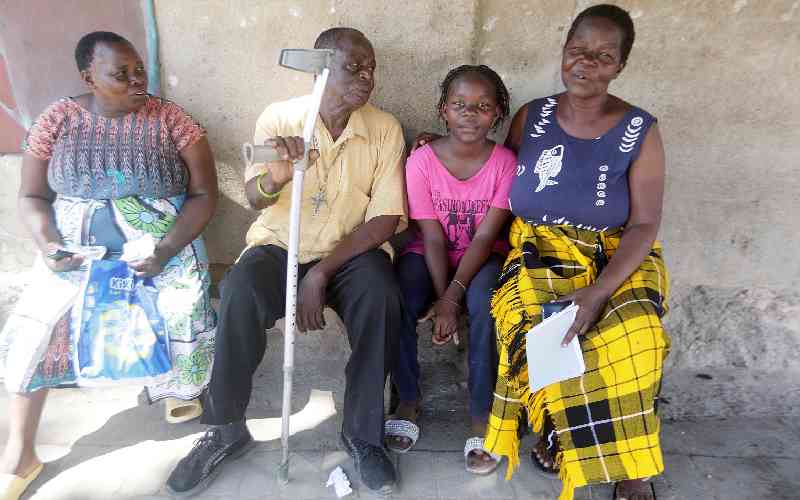In July 2020, a Kenyan court awarded Sh1.3 billion to residents of Owino-Uhuru, a slum in Changamwe, Mombasa, for damages related to pollution from Metal Refinery Limited, a lead smelting plant that recycled lead-acid batteries.
The court also ordered the government to clean up Owino-Uhuru within four months, and mandated that the payment be made within 90 days.
The compensation, however, barely offers an insight into the devastation lead poisoning has and continues to cause on the health of Owino-Uhuru residents.
The ruling came after years of grassroots work by activist Phyllis Omido, a former office worker at the smelting plant. Omido quit the plant in 2009, three months after her son became sick and was found to have high levels of lead in his blood, ingested from her breast milk.
She had also started feeling unwell during her time at the factory. Her colleagues and neighbours had similar complaints.
Residents of the Owino-Uhuru slums in Mombasa’s Jomvu area have borne the brunt of lead poisoning. It is in the air they breathe and in the water they drink and use. It is also in the soil where they farm. The very soil their children play on, and occasionally, eat. (Story on opposite page).
Yet lead is present right inside your house, and is in fact, almost always in your child’s hand.
Lead, which is a heavy metal that occurs naturally in the earth’s crust, has been known to be a potent neurotoxin for hundreds of years. Lead is especially damaging in young children – high levels of lead exposure have been associated with irreversible mental and physical damage in young children.
Lead is present in many household goods such as paint, batteries, roofing materials, ceramics, toys, cosmetics and petrol.
“In 2006, Kenya switched to lead-free petrol, a move which significantly reduced the risk of lead poisoning in Kenya. But other avenues of lead exposure such as through lead-based paint, manufacturing plants that use pipes and plumbing fixtures with lead, automobile repair workshops that use lead soldering, ceramics, and lead-soldered or painted children’s toys still pose a risk to Kenyans,” says Dr Susan Wamithi, a Developmental Pediatric Specialist at Aga Khan University Hospital.
Wamithi says recycling of lead batteries, like the case in Uhuru-Owino, is particularly dangerous if necessary precautions are not taken. “In the places where batteries are recycled, lead can seep into the soil and the water, resulting into lead poisoning in the community,” she says.
In 2014, Human Rights Watch conducted blood tests on the residents of the Uhuru-Owino to ascertain the claims of lead poisoning. This was part of a series of investigations they were conducting in Kosovo, China, Nigeria, Zambia and Thailand.
The residents informed Human Rights Watch that since the factory started its operations in 2007, their children had been sickly. Even the adults described health problems consistent with lead poisoning. The blood tests confirmed that Owino-Uhuru residents indeed had high levels of lead in their blood.
Another study published in 2018 in the Journal of Health and Pollution found that children from Uhuru-Owino had lead levels in their blood ranging from one to 30 micrograms per decilitre. While there are no official statistics, Omido alleged that 100 children and several factory workers and their wives from Owino-Uhuru died due to lead poisoning.
The smelting plant was closed in March 2014 amidst growing opposition from the public, leaving in its wake a legacy of lead poisoning that will haunt the slum residents for decades, and a reminder of just how devastating lead poisoning is.
Stay informed. Subscribe to our newsletter
The youngest are the most vulnerable
One in three children around the world have lead poisoning, which is determined by high levels of lead in their bloodstream. A recent study by Unicef and environmental group Pure Earth estimated that 800 million children around the globe had lead levels of five micrograms per decilitre or higher in their bloodstreams. This is the level of lead in the blood stream that has been determined by the World Health Organisation (WHO) as the threshold for cause for action.
According to the US Centres for Disease Control, lead poisoning is the most common environmental disease in young children, being even more prevalent than the most serious infectious diseases.
“Children are at higher risk of lead poisoning, mainly due to their hand-to-mouth behaviour. As children are exploring their world, they tend to mouth objects and fingers, this hand-to-mouth behaviour puts them at risk. In a situation where lead-based paint is flaking off the walls or furniture, a child will touch the dust on the floor or other surfaces and transfer it to their mouth,” Wamithi says.
Further compounding the issue, young children absorb lead more easily — 40 per cent compared to between 5 per cent to 15 per cent for adults. “When lead is ingested, it goes into the bloodstream, the organs, and ends up in the bones. It damages different organs. Lead is especially harmful to a child’s developing brain and nervous system,” Wamithi says.
Lead poisoning can also occur in utero. When an expectant woman is exposed to lead, she can transmit it to the fetus. This can lead to miscarriage, stillbirth, premature birth or low birth weight.
“Lead poisoning has been linked to hyperactivity, cognitive disabilities, and aggressive behaviour in older children,” Wamithi says. Lead poisoning is also associated with disorders of blood production and anaemia. Severe lead exposure can cause gastro-intestinal complications, serious brain damage, retardation, coma, convulsions and even death.
However, lead poisoning is almost never about a single event. It is highly unlikely to have instances where a child, or even an adult, is exposed to lead levels so high at one time that they will get sick. It is often an insidious month-by-month accumulation of the heavy metal in a child’s body. It might be something as seemingly innocuous as a child playing with and chewing a lead-coloured toy over weeks and months.
Undernourished children are especially susceptible to lead poisoning. This is because their bodies absorb more lead if other nutrients such as calcium and iron are lacking. The risk is magnified in children who have pica, a psychological disorder that causes persistent and compulsive cravings to eat non-food items. Children suffering from pica are more likely than other children to eat lead-contaminated soil and pick away at and eat leaded paint from walls and furniture.
A simple blood test can determine whether a child has accumulated dangerous amounts of lead in their body. Screening to determine adverse effects of lead poisoning can be done at 12 months and 24 months of age. Many of the symptoms of lead poisoning in a child might not be clear up to that point.
Effects of lead on intelligence
Studies show that lead damages a child’s brain by interfering with the growth and development of the central nervous system. Lead poisoning might damage the nerve’s ability to carry messages, which explains most of the symptoms.
A long-term study published in the Journal of the American Medical Association in 2017 found that 500 children who might have been exposed to lead from gasoline may have had a loss of intelligence and occupational standing by the time they reached age 38. The subjects of this study were born in Dunedin, New Zealand, in 1972 and 1973. During their childhood, New Zealand had some of the highest gasoline lead levels in the world.
The study participants found to have more than 10 micrograms of lead per decilitre of blood at age 11 had IQs at age 38 that were, on average 4.25 points lower than their less lead-exposed peers. Alarmingly, these adults were also found to have lost IQ points relative to their own childhood scores. For each 5-microgram increase in blood, the study found that the person lost 1.5 IQ points.
Are there safe levels?
Over the years, as scientists learn more about the insidious effects of lead poisoning, the “level of concern” for lead exposure has been adjusted downwards. In the 1990s, blood levels of 10 micrograms of lead per decilitre of blood were seen as acceptable. In fact, the children in the New Zealand study weren’t given any special treatment — there were no interventions to forestall effects because nobody thought their lead exposure was abnormally high.
“There are no safe levels of lead exposure in both children and adults. There is a genetic element that determines susceptibility to lead poisoning and its effects. Children with the same level of exposure to lead might respond differently,” explains Wamithi.
With this in mind, prevention is the single most important way of dealing with lead poisoning. “The government has a big role to play in preventing lead poisoning through making and enforcing the necessary regulations. Other than that, parents can keep their children safe through trying to stop the hand-to-mouth behavior and hand-washing,” Wamithi recommends.
Government regulations
In the developing world, which accounts for 99 per cent of global incidences, lead poisoning is a major source of concern. In these countries, the risk of exposure is increased by poor enforcement of industrial pollution safeguards.
Although poorly enforced, the Kenyan government has strong environmental laws and regulations to protect citizens from environmental degradation and harm. The Environmental Management and Coordination Act contains stipulations to prevent industries from polluting the environment. For instance, before a factory begins operations, they must undertake an Environmental Impact Assessment. The Act also stipulates that those responsible for pollution that harms people and the environment face imprisonment and/or financial penalties. The Kenyan constitution also guarantees citizens the right to a healthy environment and fair working conditions. Additionally, Kenya has membership in several esteemed communities that advocate for human rights and the environment.
 The Standard Group Plc is a
multi-media organization with investments in media platforms spanning newspaper
print operations, television, radio broadcasting, digital and online services. The
Standard Group is recognized as a leading multi-media house in Kenya with a key
influence in matters of national and international interest.
The Standard Group Plc is a
multi-media organization with investments in media platforms spanning newspaper
print operations, television, radio broadcasting, digital and online services. The
Standard Group is recognized as a leading multi-media house in Kenya with a key
influence in matters of national and international interest.
 The Standard Group Plc is a
multi-media organization with investments in media platforms spanning newspaper
print operations, television, radio broadcasting, digital and online services. The
Standard Group is recognized as a leading multi-media house in Kenya with a key
influence in matters of national and international interest.
The Standard Group Plc is a
multi-media organization with investments in media platforms spanning newspaper
print operations, television, radio broadcasting, digital and online services. The
Standard Group is recognized as a leading multi-media house in Kenya with a key
influence in matters of national and international interest.









